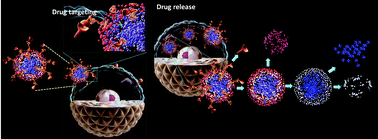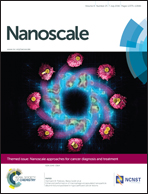Stimuli-free programmable drug release for combination chemo-therapy†
Abstract
Combinational chemotherapy capable of targeted delivery and programmable multi-drug release leads to enhanced drug efficacy, and is highly desired for cancer treatment. However, effective approaches for achieving both features in a single treatment are limited. In the present work, we demonstrated programmed delivery of both chemotherapeutic and immunotherapeutic agents with tumor cell targeting capability by using SiO2 based self-decomposable nanoparticulate systems. The programmable drug delivery is realized by manipulating drug loading configurations instead of relying on external stimuli. Both in vitro and in vivo results showed specific drug binding to FAT1-expressing colon cancer cells. The loaded dual drugs were demonstrated to be delivered in a sequential manner with specific time intervals between their peak releases, which maximize the synergistic effect of the chemotherapeutics. These features led to significantly enhanced drug efficacy and reduced system toxicity. The tumor weight decreased by 1/350, together with a moderate increase in rats’ body weight, which were observed when adopting the dual drug loaded nanoparticles, as compared to those of the control groups. The present system provides a simple and feasible method for the design of targeting and combination chemotherapy with programmed drug release.

- This article is part of the themed collection: Nanoscale approaches for cancer diagnosis and treatment

 Please wait while we load your content...
Please wait while we load your content...